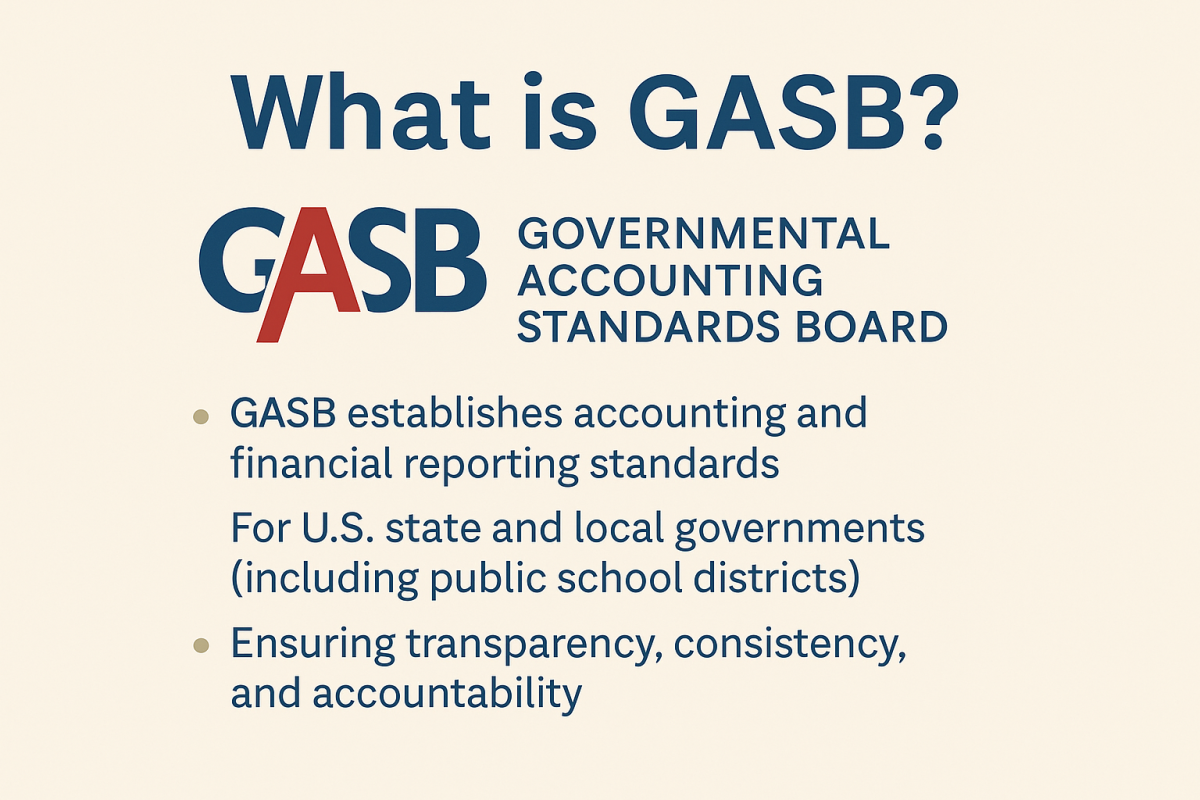
As the school year winds down and we juggle yearbook distribution, prom, graduation, senior events, next year’s registration, banquets, and end-of-year budgets, one acronym keeps popping up: GASB (Governmental Accounting Standards Board). The district keeps pressing me to submit all of my budgets, and I’ve found myself wondering: What exactly is GASB, and why am I dealing with it if it’s supposedly a “district thing”?
Even after 35 years in this work, there are still things I come across that I’ve never dealt with, or even heard of. I’d caught echoes of this GASB thing in the past, but this year, my district is going all in. They’ve asked us to complete next year’s budgets, broken down by income, expenses (materials, supplies, capital), and a clear definition of carryover.
If I’m suddenly knee-deep in this, I figured some of you might be too, whether you’re already dealing with it, just starting to hear about it, or blissfully unaware (for now). Either way, it’s probably coming your way. So, what is GASB?
GASB stands for the Governmental Accounting Standards Board. It’s the organization that establishes accounting and financial reporting standards for U.S. state and local governments, including public school districts in California.
Here’s a simple breakdown:
What GASB does: It creates rules for how government entities (like school districts) record, manage, and report financial information.
Why it matters: These rules ensure transparency, consistency, and accountability in how public funds—including Associated Student Body (ASB) money—are used.
Who follows GASB: Your school district follows GASB standards when preparing financial reports and budgets. As an Activities Director, you follow your district’s procedures, which are based on GASB rules.
Key Takeaways for You:
GASB doesn’t govern ASB directly, but your district’s policies (especially for handling money, budgeting, and audits) are shaped by GASB standards.
This is why there are so many rules about receipts, approvals, meeting minutes, and how funds are used—it’s all to stay in line with GASB-inspired regulations.
Ultimately, GASB helps ensure that student funds are handled legally, ethically, and responsibly.
How does this affect me? As an Activities Director in California, GASB affects you primarily through how Associated Student Body (ASB) funds are managed, reported, and audited.
Here’s how GASB might impact your role:
1. Financial Transparency and Accountability
GASB sets the rules for how school districts report finances, including student body funds. Even though ASB funds are student-run, they are public funds held in trust by the district. You must ensure:
Accurate recordkeeping of ASB transactions.
Compliance with district and state financial policies shaped by GASB standards.
2. Audit Readiness
Annual audits of your school’s ASB accounts check for compliance with GASB and district regulations. As Activities Director, you’re often the adult advisor overseeing student finances, so:
Be sure all income and expenditures are properly documented.
Ensure minutes from student meetings include financial approvals.
3. Budget Reporting and Fund Management
GASB influences how funds must be reported (e.g., fund balances, restricted vs. unrestricted funds). You need to:
Work closely with your school’s financial clerk and district office.
Help student officers understand their responsibilities when handling money.
4. Training and Oversight Responsibilities
Districts may require you to complete financial training or certification because of GASB-related policies. You play a key role in:
Training students in responsible fiscal practices.
Ensuring compliance with board policies influenced by GASB standards.
Bottom line: You don’t need to know every GASB statement by heart, but understanding the importance of fiscal responsibility, transparency, and proper documentation is essential. It helps protect your students, your school, and yourself.
Now we know! So, I turned to AI and asked for some takeaways to help us as. Here’s a Student ASB Financial Procedures Checklist tailored for California schools. It’s simple, practical, and can be used as a quick reference or even as part of officer training:
Student ASB Financial Procedures Checklist
Before Spending Money
Get Approval First: All expenses must be approved in advance by a vote in an ASB meeting (recorded in the minutes).
Complete a Requisition Form: Fill out a requisition with item details, estimated costs, and signatures.
Check the Budget: Make sure funds are available for the purchase.
When Collecting Money
Use Pre-Numbered Receipts: Every payment received should be receipted.
Fill Out a Cash Box Request (if needed): Request a secure cash box before events.
Deposit Daily: Turn in money daily to the school bookkeeper—never keep it overnight.
Complete a Cash Collection Report: List all sales, ticket numbers, or items sold.
After Spending Money
Submit Invoices or Receipts: Attach all original receipts to the payment request.
Never Pay Out of Pocket: Always go through the district-approved process; no reimbursements without prior approval.
Thank Vendors: Include a student-written thank you if you worked with a local business.
ASB Meeting Responsibilities
Review Treasurer’s Report: Regularly review and ask questions about income and expenses.
Document All Votes: Meeting minutes should reflect all financial decisions and votes clearly.
Follow Your Constitution: Stick to your club or ASB bylaws when making decisions.
Good Habits
Be Transparent: Let classmates know how funds are being used.
Keep Everything Organized: Store records in a shared binder or digital folder.
Ask When Unsure: Check with the Activities Director or Financial Clerk.
At the end of the day, GASB isn’t out to make our lives harder, it’s about ensuring public funds, including our students’ money, are managed transparently and responsibly. While it might feel like one more layer of paperwork, it’s also a chance to model accountability, fiscal responsibility, and good leadership for our student body. As Activities Directors, we’re not just event planners, we’re stewards of student trust and district resources. So let’s lean into this challenge together, ask the right questions, and help each other stay on top of the shifting landscape. You’ve got this—and you’re not alone.